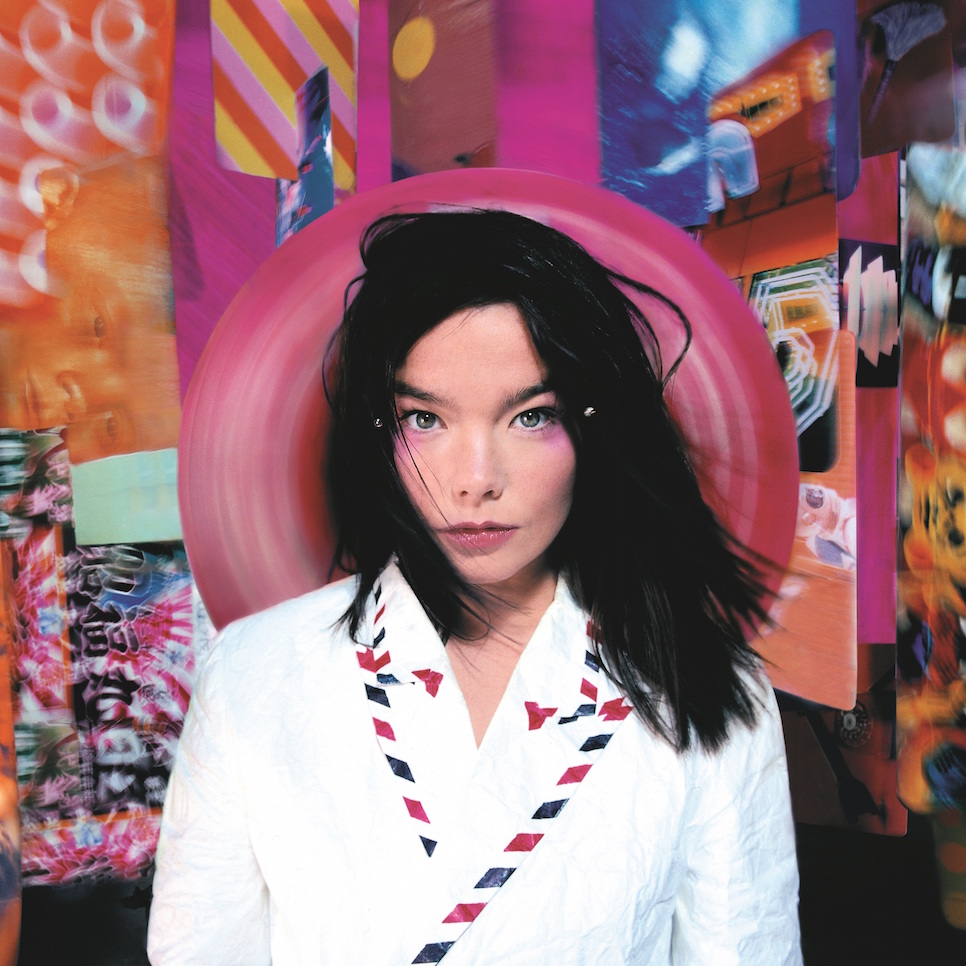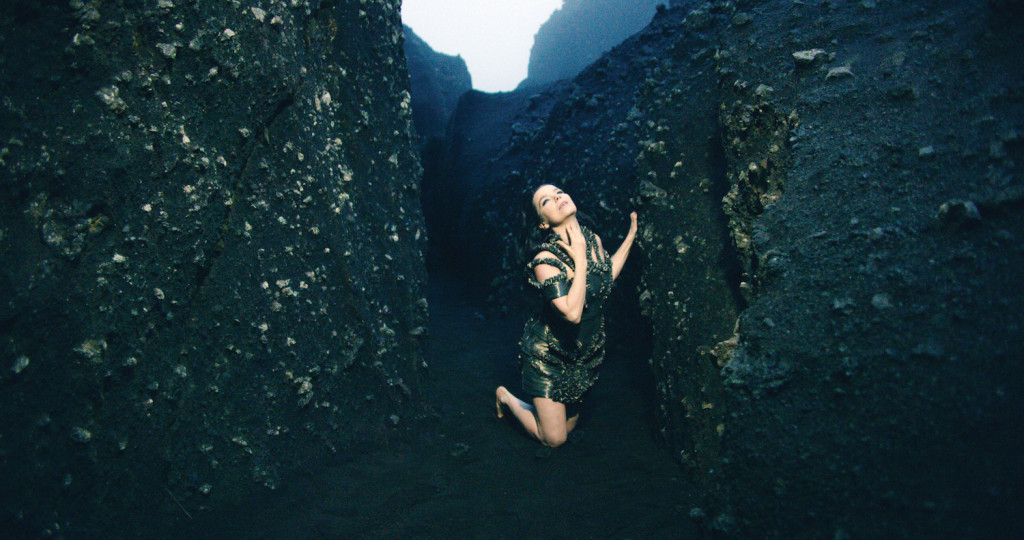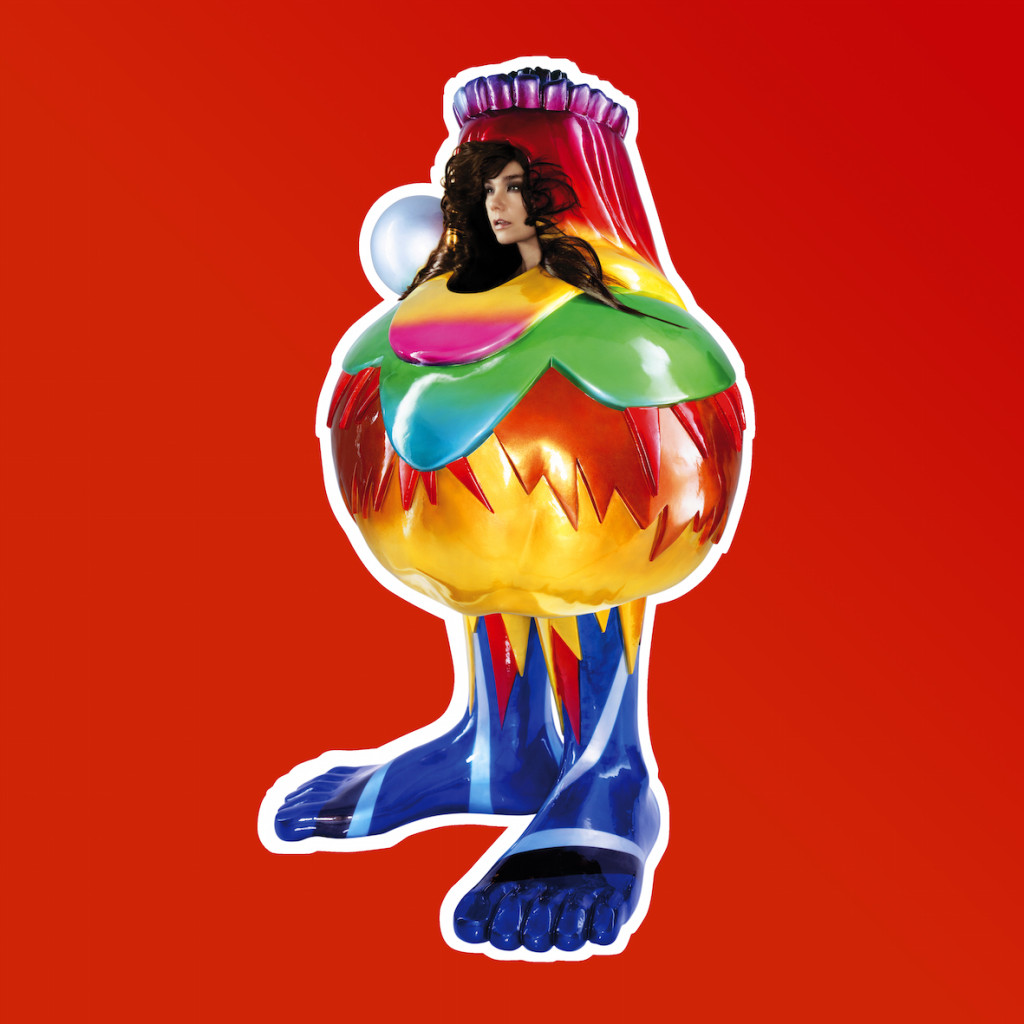All is Full of Love, or only to some as it may seem. Opening March 8th at the Museum of Modern Art in New York is a retrospective of sorts on the career of Icelandic, New York based singer and songwriter, Bjork. Curated by Klaus Biesenbach, Director of MoMA PS1 and Chief Curator at Large at MoMA, the exhibition focuses on the last 20 years of Bjork’s career, her elaborate costumes and eclectic videos. Having mixed feelings on the show, I’ve decided to divide my thoughts into two categories; The Fan and The Art Critic. Both iterations from each of these dualities are below.

Bjork, Post, Album cover, 1995, Photograph by Stephane Sednaoui, Image courtesy of Wellhart LTD and One Little Indian
The Fan:
I remember the first time I heard Bjork’s squeaky yet melodic voice, right before her then band The Sugarcubes (1986-1992) broke up and her solo career began. Her first album, appropriately titled Debut (1993) included songs with titles such as “Violently Happy” and “Human Behavior” and what angsty teenage girl could resist? In excerpt:
I tip-toe down to the shore
stand by the ocean
make it roar at me
and I roar back
’cause i love you
but you’re not here.
With deep bass drum beats mixed with catchy dance beats, Bjork emerged a star. Her songs spoke of longing, love, heartbreak, misunderstanding, all the fodder perfect for the 1990s and a grange, Post-Pop music scene. Her second solo cleverly called Post (1995) again continued a deliciously unique, and difficult to categorize sound that only she was known for. Musically she teetered between trip-hop, electronica, dance, with a big band flair. Everything about her was big except for her size. At 5′ 4″ she is small in stature but with a big energy and vision. Post was one of my favorite albums for several years. The songs seemed to reflect my life or the life I wanted. Being a late teen and then into my early twenties, songs like “Hyperballad”, “The Modern Things”, “You’ve Been Flirting Again” and “Possibly Maybe” made me inextricably giddy. From “Possibly Maybe”:
How can you offer me love like that?
My heart’s burned
How can you offer me love like that?
I’m exhausted
Leave me alone
Possibly maybe,
possibly maybe,
possibly maybe.
Since we broke up
I’m using lipstick again
I suck my tongue
In remembrance of you.
Her poetic nature oozed through her lyrics, giving life to emotional content that we all carry close to our hearts. She dealt with beginnings and endings, in a lyrical way that was at times violent but graceful. The stretch of her career was only just in its embryonic stages and following Post, was Homogenic (1997), Vespertine (2001), Medulla (2004), Volta (2007), Biophilia (2011) and the soon to be released Vulnicura (2015). From the viewpoint of a fan, the exhibition at MoMA dutifully presents artifacts from her career; mosaics, colorful and unique. Each item of clothing, including a pair of deliriously clunky red platforms she wore in the “Hyperballad” video designed by Walter van Beirendonck, speaks to a specific generation and moment of time. An audio accompanies part of the exhibition, vocals fed through a hand-held iPod that register according to the room the visitor happens to be in. Technologically, the sound is relevant when looking and the sync of her music with the visual of the items present is important to the experience. The show requires patience but many fans who worship these objects, this time, the music and mind of this performer will oblige and surrender to the audio prompts. At nearly fifty years old, Bjork is a force to be reckoned with.

Bjork, Still from Black Lake commissioned by the Museum of Modern Art, New York, directed by Andrew Thomas Huang, Courtesy of Wellhart and One Little Indian, 2015
The Art Critic:
The Museum of Modern Art has entered into a foray of pop-culture and entertainment, teetering a fine line between fine art and commercialization of media (film and pop-music). First with the exhibition Tim Burton (November 2009-April 2010) which received mixed levels of acclaim and disdain, the museum mostly known for specific and first-rate collections of Modern art, painting, sculpture and furniture design, took a step into communication with a generation and particular selection of the general public, those who are engaged in popular culture more so than fine art. Tickets were sold, throngs of visitors stood on lines for months and peered over each other’s shoulders to get a glimpse of Tim Burton’s drawings and sculptures. But could this work, made for the most part, in relation with big budget cinema, be considered worthy of the wall’s of the Museum of Modern Art and not the Museum of the Moving Image?
Such brings us to the present and the current exhibition at hand, honoring songstress Bjork. Opening March 8th, people all over the world will anxiously rush and wait with bated breath for the chance to see items such as the actual Swan Dress (2001) designed by Marjan Pejoski and worn by Bjork to the 73rd Academy Awards. Highlighting the extensive costumes worn during performances, in videos directed by the likes of Spike Jonze, Michel Gondry and Nick Knight, the exhibition presents a look at the wide-ranging artistry of Bjork’s musical ventures. But is it worthy of MoMA? In short, yes and no. Videos are available for viewing on general monitors, dresses can be looked at on awkwardly grinning mannequins and lyrics scribbled in notebooks can be read behind glass. The true artistry that has resulted in Bjork’s life has exited the hall of the museum. The audio portion is actually quite boring and what promises to be forty minutes, took me fifteen or twenty to walk through. In an exhibition that has been touted as one of the most high-profile for MoMA, any expectation I had, were unfortunately not met. With a platform such as MoMA, a budget fit for a rock star such as Bjork, I hoped that the element of performance would have been more in the forefront. This is New York! Singers could have been hired to sing songs live and videos could have been screened in the round in both instances, immersing the viewer, giving he or she a true experience beyond that of didactic observation.
As part of the exhibition, MoMA commissioned a new film (aka music video) by Bjork. Titled “Black Lake” and directed by Andrew Thomas Huang, the film is shown in a stifling hot room that is supposed to mimic the feeling one might have in a cave, unfortunately it doesn’t. Split onto two, rectangular facing screens, the film finds Bjork in a dirt cave or tunnel, purportedly singing live but the track is a bit off and she appeared to be lip syncing. Punching the dirt, wearing fabulous clothes but never truly getting dirty, she gyrates and beats her chest but somehow the passion or self-angst from days of yore seems to have vanished, maybe the irrational physicality of youth not as readily accessible. In a partnership and now separated* from artist Matthew Barney, her new album (also debuting unofficially with the MoMA show) Vulnicura is a reflection and meditation on their relationship and it’s demise. The video does remind us that at fifty she is showing signs of age and is fabulous. The song is enjoyable, catchy, dark but with a big chorus that only Bjork can promise. However in the context of the Museum of Modern Art, the exhibition falls flat. Less dynamic than the retrospective The Fashion World of Jean Paul Gaultier: From the Sidewalk to the Catwalk at the Brooklyn Museum (October 2013-February 2014), MoMA sadly attempts to show us Bjork, by removing Bjork and the true artist she actually is.

Bjork, Costume by Bernhard Willhelm, German, born 1972
Body Sculpture, 2007
Styrofoam with laquer spray paint
72 × 38 × 38″ (182.9 × 96.5 × 96.5 cm), Museum of Modern Art, 2015
More soon!
xo
*Note, this article originally mentioned Bjork and Matthew Barney as a couple and now the corporeal performative gesture in “Black Lake” can be better understood. As The Fan, it makes her more lovable and brave for finding artistic inspiration in heartbreak…unwittingly returning to the past.
